By Caroline Baum
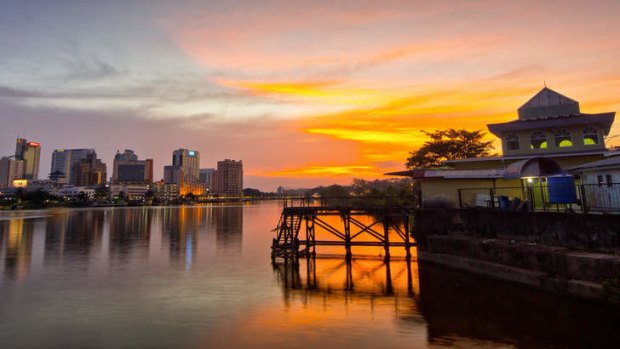
Captivating: Kuching from across the river.Credit: Getty Images
The laid-back capital of Sarawak is a refreshing change from the frenetic megacities of Asia, writes Caroline Baum.
You learn a lot about a place when things go wrong. On my first day in Kuching, the capital of Sarawak (still better known by its colonial name of Borneo to adventure travellers, the majority of visitors), there was an unprecedented power failure. Electricity went off for six hours throughout the island, which had never happened before.
Somewhere bigger, somewhere more sophisticated, there would have been chaos. Everything would have ground to a halt and tempers would have frayed in massive traffic jams, but in Kuching, with a population of 700,000, none of that happened. No one even beeped their horn when traffic got a bit clogged. As my driver put it without irony, "That's because no one really has to be anywhere".
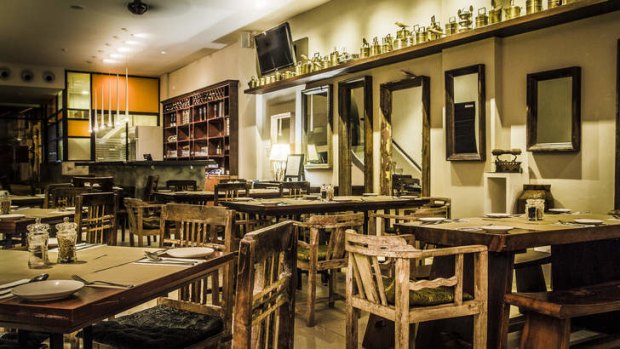
M bar and bistro at The Ranee boutique hotel.Credit: Caroline Baum
Quite. Kuching is a sleeping princess, though not a sleeping beauty, for she is too careworn for that. Her charms lie beneath the surface.
A seaport slumbering gently on the banks of the Sarawak river, Kuching is not a destination on most people's itineraries, except as the jumping-off point for jungle trekking, but there are other reasons to linger.
The city is an undiscovered foodie heaven, as that first night in the blackout demonstrated.
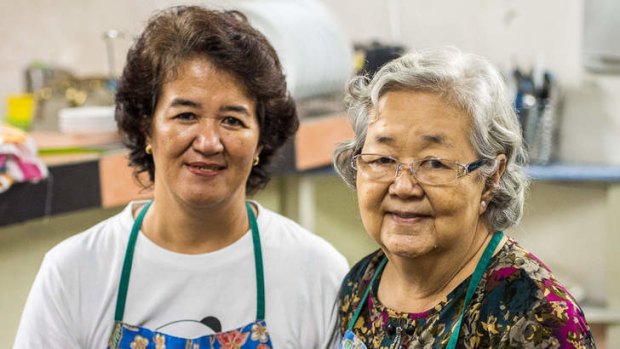
Serena and her mother, who run Bumbu Cooking School.Credit: Caroline Baum
Local friends took me to Top Spot, a restaurant that sounded distinctly unappealing, located on top of a multi-storey car park.
How would it cope without power? I wondered, walking up the six flights of stairs while the lift was out of service.
The answer: brilliantly. There must have been more than 500 people up there, ordering fish from hawker stalls and choosing how to have it cooked. Dozens of gas burners and giant woks flared in the darkness. The place was jumping, proof of a lively social scene.
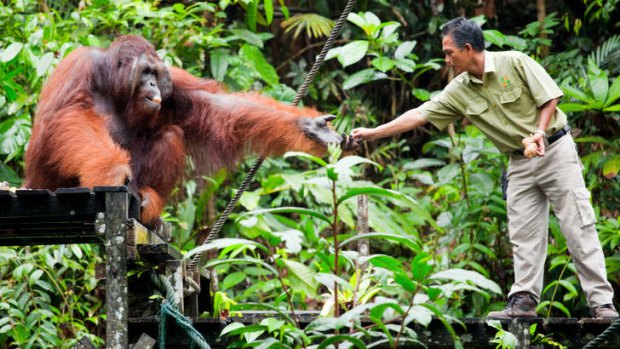
An orang-utan at Semenggoh Wildlife Centre.Credit: Alamy
I can't tell you what I ate, because I couldn't see it, but I recognised the tang of tamarind and the zing of a lime and lemongrass marinade. Later, I learnt that the raw marinated fish dish I enjoyed was umai, a typical fisherman's lunch, traditionally eaten while out on the water.
As a preamble to a cooking class, a trip to the Satok wet market was eye-opening evidence of how regional the cuisine of Sarawak is, featuring dozens of unfamiliar tropical ingredients presented by tribal stall holders and farmers. Fresh palm hearts and delicately curling fern fronds (midin, stir-fried and eaten crunchy with ginger and garlic), red rice, bamboo shoots, a dozen varieties of banana and plantain, fragrant and versatile edible leaves, strangely shaped brightly coloured fruits and vegetables, many of them with medicinal properties, piled high and squeaky fresh.
Appearances here can be so deceptive. Bumbu Cooking Class looked unprepossessingly modest: just a couple of gas burners and a table set up in the back room of a laneway shopfront. But the no-frills, hands-on, four-hour class by Serena and her shy mother gave an intensive introduction to the subtleties of local curry, cooking fiddle-head fern tips and folding a pandanus leaf to form a small container for a coconut custard.
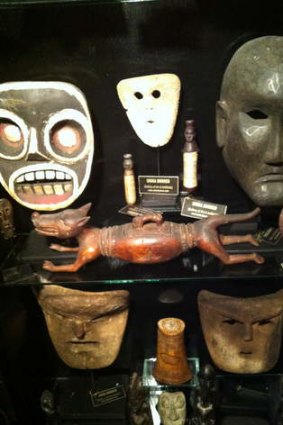
Masks for sale at the waterfront.Credit: Caroline Baum
Their no waste-policy included turning pineapple skin into an effective, all-purpose cleaner. (Another useful tip: lemongrass tea is a good mosquito repellent.)
Strolling the streets of the bazaar in the old town rewards the patient visitor. At first you might think there are no shops of interest, but look again between the dusty laneways, pungent with the aroma of salted dried fish. Intricately woven rattan baskets and mats, carvings of local Belian hardwood, traditional fabrics and glass beads like those originally traded by Venetian merchants are to be found, alongside discreet emporiums selling plumed and shell-decorated tribal headgear and ceremonial jewellery that would not look amiss in a museum.
Another important pit stop is The Black Bean, a tiny hole-in-the-wall cafe. The house-roasted, locally sourced coffee here is fresh and strong. Pick up bargain-priced vacuum-packed beans to bring home or cool down with a bracing, iced cappuccino.
There is a thriving but under-the-radar traditional craft culture here, as annual bead and textile conferences attest, but it has not been commercialised for the tourist trade beyond the obvious trinkets. There is mercifully little tat on offer - if you disregard the hideously kitsch miniature cats sold everywhere. Kuching means "cat" in Malay and the city suffers from several unfortunate feline landmarks, including a cat museum that you would have to be very desperate to visit.
A good place to see quality craftsmanship in a contemporary showcase is the upscale Ranee boutique hotel, the first of its kind in the city, signalling a new era in Kuching hospitality. The Ranee is a stylish, hip, well-located oasis. Its decor combines the aesthetic of Sarawak's tribal peoples with an urban, cosmopolitan edge.
Proprietor Rosemarie Wong is a worldly, sharp-eyed collector and arts entrepreneur spearheading a push to lift Kuching's profile and woo independent travellers who want five-star comfort.
Wong is an effective champion for local artisans. The Ranee's foyer ceiling and many guest rooms are decorated with intricately woven coloured rattan mats featuring elaborate patterns of plants and animals that hint at indigenous animist beliefs.
Suites are decorated with bold wallpapers that owe nothing to the clicheed Western interpretation of Asian good taste. God help you if you have a hangover, although the lavishly appointed bathrooms with deep tubs might help make the recovery painless.
Across the river from The Ranee is the most prominent symbol of Sarawak's aspirations to a new identity in the region. The state legislative assembly, known as the DUN, dominates the city, a spectacular landmark and a fitting monument to the island state's independence. At night its traditional payung (umbrella) roof and archways are beautifully lit, making it look like a cross between an exotic flower and a spacecraft ready for lift-off.
The esplanade, a popular place to stroll before an early-evening storm or dinner at one of the absurdly cheap shophouses, is a monument to Sarawak's colonial past under the so-called white rajahs, a British dynastic family of rulers from the 1840s founded by James Brooke (the shooting of a film about their lavish lifestyle is due to begin in the city this year, generating feverish speculation about casting).
The small, whitewashed jail and civic buildings they built, with their shady colonnades and highly polished teak floors, are modest in scale and decoration, lacking in pomposity and formal grandeur. Today, there is something appealing about their lack of pretension.
Local museums housed in some of these historic buildings provide a crash course in the island's complex tribal history and the different cultures of the Iban and the Dyak people, renowned headhunters who lived in longhouses.
Tours to see the modern-day version of traditional village life are available from local operators, but learning how to use a blowpipe and attempting to play a nose flute feels a bit awkward.
Budget-conscious travellers don't have to sacrifice style at the Singgahsana Lodge run by dynamic duo Donald and Marina Tan, who embody an energetic, global vibe.
The couple are commited to the future of Sarawak as a developing destination. Worldly and cosmopolitan, passionate ambassadors for the island, they have come home after doing their fair share of Lonely Planet-style travel and living abroad.
Accommodation here is guesthouse style, with shared bathroom facilities and lots of stairs, which may not suit everyone.
The rooftop terrace of their central location is an after-dark hub for spontaneous music jams. On the night I visited, one guest serenaded us with a ukulele, a preamble to the program on offer at the Rainforest World Music Festival, an annual highlight in the island's calendar.
Held in a rainforest clearing about an hour from Kuching near the beach at Santubong, the festival features ethnic sounds from around the world. Think of it as a mini WOMAD.
On a balmy evening, bats flitted between the trees and the sky crackled with lightning and the percussive roll of thunder. Rhythm in Bronze, a mostly female Malaysian gamelan orchestra thrilled the audience, especially when they teamed up with a flamenco guitarist.
The rest of the evening included performances from France, Denmark and Colombia. The crowd was young and benign: one of the pleasures of non alcohol-soaked cultures.
Minutes from the venue, the Tans have turned their personal jungle beach retreat into the very cool Village House, a laid-back sanctuary set around a 14-metre pool and bar, where the festive atmosphere continues into the night. The rooms have a higher level of comfort than their city counterpart, with four-poster beds, plasma TVs and private verandahs. Visitors with energy to burn who like a challenge may attempt the five-hour trek and climb of Mount Santubong, but there are less-strenuous activities here, ranging from wildlife spotting to golf.
The most popular excursion from the city is to the nearby Semenggoh Orang-Utan Sanctuary, where the animals have been rescued from abuse or born into a protected environment. Whatever their history, these are wild animals who appear on their own schedule or not, so it's best to have low expectations, especially in fruiting season between November and January, when the animals can find most of their own food themselves.
Not long before I arrived, a male had killed a female. You can never tell what to expect from these unpredictable creatures.
Nothing prepares you for the thrill of seeing the trees shake with the unmistakable rhythm of orang-utans descending like lanky limbed rag dolls, carefully selecting vines to swing on. Their grace as they build up momentum is something you can never fully appreciate in captivity, where their room to move is limited. I was lucky enough to see a family group, including a mother with a 10-day-old baby clutched to her chest, its head the size of a tennis ball.
After helping themselves to whole coconuts, they scrambled up to knock the nuts open against tree trunks, the forest resonating with their persistent tapping.
If the short trek to see the orang-utans tempts you to go further, there are lots of ways to experience more of the abundant natural wonders and wildlife that make the island a unique habitat for many rare and endangered species. No wonder David Attenborough is coming back again this year.
A short flight away are spectacular limestone caves in Mulu National Park, including the famous bat cave filmed by Attenborough, from which 3 million bats make their daily exodus to feast on half a ton of mosquitoes every night, before returning to their dark home.
Knowledgeable, eagle-eyed guides will spot every bird, monkey, reptile and insect in the vicinity of a moderate three-hour walk. Further afield, the strange limestone pinnacle shards poking out of the virgin rainforest are accessible only to determined and experienced hikers, protecting them from mass tourism, for now at least.
The decision to create a new precinct away from the historic centre of Kuching means that the area can develop a fresh new professional identity, without jeopardising the character of the older neighbourhoods, unlike many other Asian capitals, which have simply bulldozed shabby old streets in the name of progress, with soulless results. Fortunately, someone here has an enlightened attitude to heritage.
Eight kilometres from the city centre and accessible by riverboat, the Sarawak Convention Centre is the hub of a new development. With a marina and retail complex to come, it means Kuching can catch up on its rivals and attract a business clientele to boost the local economy and supplement its dependence on primary commodities. Mining, palm oil and forestry have put the natural environment under stress, reducing the wildlife habitat that attracts eco-tourists.
Like the stunning palm-grove-inspired airport roof at Kuala Lumpur airport, the convention centre's design acknowledges Sarawak's enduring connection to the rainforest with a distinctive roof shaped like a ririk leaf, commonly used by Iban tribes-people to wrap rice and other foods. It has another, less-obvious but unique feature: there are not too many other places in the world where conference delegates may glimpse crocodiles sunning themselves on the banks of the river at a safe distance. Nature is never far away in Kuching. See her now, before the inevitable facelift wipes away her sleepy smile.
The writer was a guest of the Sarawak Convention Bureau.
GETTING THERE
Malaysia Airlines has a fare to Kuching for about $900 low-season return from Sydney and Melbourne, including tax.
Fly to Kuala Lumpur (about 7hr) and then to Kuching (1hr 45min). See malaysiairlines.com.
STAYING THERE
The Ranee, 6/7 Main Bazaar, see theranee.com.
Singgahsana Lodge, first floor, 96 Main Bazaar. See singgahsana.com.
SEE + DO
Semanggoh Orang-Utan Sanctuary. See sarawakforestry.com.
Bumbu Cooking Class, 57 Carpenter Street Sarawak. See bumbucookingclass. weebly.com.
Rainforest World Music Festival, June 20-22. See rwmf.net.
TRIP NOTES
MORE INFORMATION
FOUR PLACES TO EAT IN KUCHING
JUNK, 80 JIN WAYANG
A stylish and popular shophouse with a fusion menu that has Western dishes alongside Malaysian favourites. Generous portions.
DULIT COFFEE HOUSE, TELANG USAN HOTEL, BAN HOCK ROAD,
Locals come here for the excellent traditionally cooked Dayak food such as pansoh manuk and chicken cooked in bamboo.
MING HONG KEE, JALAN PADUNGAN.
A favourite among expats and locals for its typical curry-free Sarawak laksa.
TOP SPOT
It's on the sixth floor, multi-storey car park, Jalan Padungan.
Sign up for the Traveller Deals newsletter
Get exclusive travel deals delivered straight to your inbox. Sign up now.